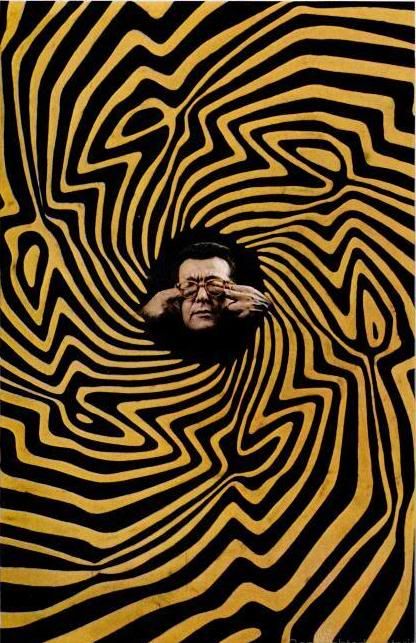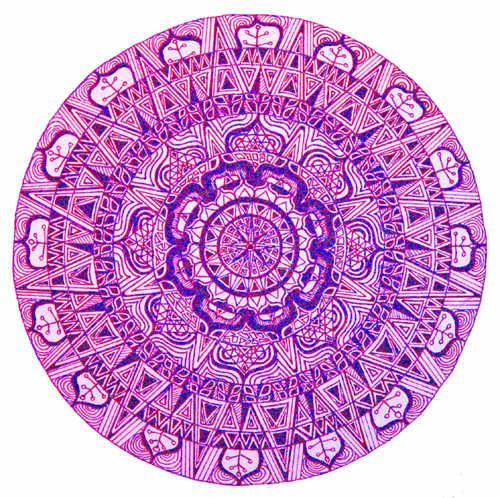
A few years ago my dad gave me a copy of the September 1966 issue of LIFE magazine. At the time I was experimenting with hallucinagins collages and he thought I could possibly use some of the trippy imagery for a future piece.
While I did not end up mangling the magazine, I did enjoy reading the main feature regarding psychedelic art (starts on pg 60), specifically the bits about phosphenes.

“For Brooklyn chemistry professor Dr. Gerald Oster, a single trip on LSD was all it took to launch him on an art career.’It made a fabulous impression’ he recalls. What struck him particularly was the ‘stunning magnificence of phosphenes’ those dancing dots, spirals, radial lines and other luminous images that one can see when the eyes are closed or the fingers are pressed against the lids. To convey “the spirit of this marvelous internal visual phenomenon” Dr. Oster began to make paintings whose geometric and spiral patterns incorporate the effects of visual bounce, blur and pull familiar to Op art. In addition, the patterns are painted in phosphorescent colors which glow in the dark like phosphenes and even change shapes as their brightness diminishes.”
I’ll stick with jamming fingers into my eyeballs in lieu of acid, but I was pleased to learn the lava lamp of my inner eyelids finally had a name.
While I’m here. What is Op Art?

Op art, also known as optical art, is style of abstractionism popular in the 1960s; it produces dramatic visual effects with colors and contrasts that are difficult for the eye to resolve. “Optical art is a method of painting concerning the interaction between illusion and picture plane, between understanding and seeing.” Op art works are abstract, with many of the better known pieces made in only black and white. When the viewer looks at them, the impression is given of movement, hidden images, flashing and vibration, patterns, or alternatively, of swelling or warping.
———————————
Back to phosphenes, so what is actually going on?

A phosphene is an optical phenomenon that is characterized by perceiving light when there is no light entering the eye. It is an entoptic phenomenon, meaning that the source of it lies within the eye or visual system itself.
Phosphenes are most often induced by some kind of direct stimulation of the retina, whether mechanical, magnetic or electrical. The random discharge of an electrical signal from a single cell within the visual system can also cause a phosphene.
Pressure phosphenes are the most common type, and these occur when mechanical pressure is placed on the retina, such as by rubbing the eyes. A pressure phosphene usually persists only while rubbing the eyes and for a short time after. These effects were detailed by the ancient Greeks and Isaac Newton, among others.
Another common phosphene related to this first type is the kind that happens following a blow to the head or a heavy sneeze. When we see “stars” in these situations, it is due partially to retinal stimulation, as well as stimulation of other areas of the visual system, including the visual cortex of the brain.
It has also been reported that astronauts sometimes experience phosphenes in space, presumably due to the higher levels of radiation present in space, compared to on Earth.
——————————————-
Phosphenes’ Influence on Art

Example of a Tibetan Mandala
Long before the LSD Art of the 60’s, research suggests that the phenomenon has been a source of inspiration throughout human history.
In 1989, researcher Richard Bradley applied the concept of phosphenes to European megalithic art. He attributed many mysterious cave drawings with the phosphene visions of the ancient artists. Art historian A.E.Iribas has traced the influence of phosphenes on such art as:
- the “childlike” art of Miro
- the psychedelic art of Michaux
- the surrealist art of Dali
- the mandalas of Tibetan Buddhism
- the architecture of temples
- alchemical imagery
- Hildegard von Bingen’s illuminations
- the work of contemporary painters such as Onslow-Ford, Kupka, Kandinsky, av Klint, and others
——————
Credit Where Credit is Due
Check out One Letter Words for more information on phosphenes and as always, Wikipedia has a complete run down of the phenomenon along with associated articles concerning closed-eye hallucinations, “Prisoner’s Cinema”, and scintillating scotoma.

(Photograph by Irvine Penn and serigraph construction by Gerald Oster)
Hopefully I have either made a “Star of the Company Holiday Party” or “Future Burning Man Ticket Holder” out of you.♥




